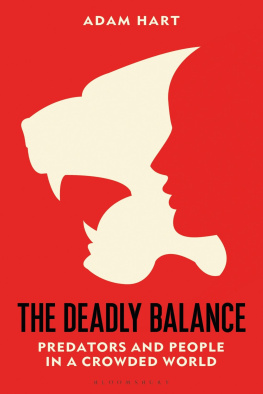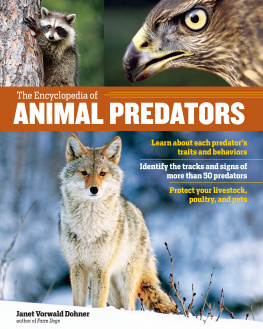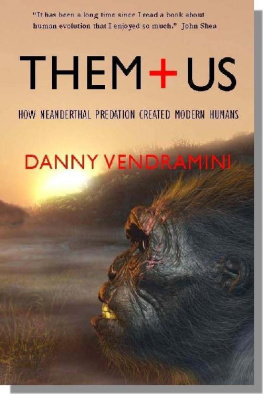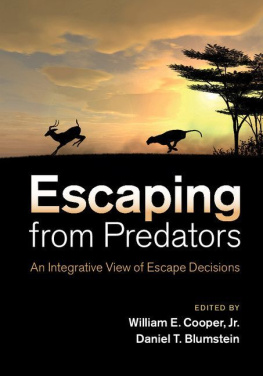Human Predators and Prey Mortality
Human Predators and Prey Mortality
Edited by
Mary C. Stiner
First published 1991 by Westview Press, Inc.
Published 2018 by Routledge
52 Vanderbilt Avenue, New York, NY 10017
2 Park Square, Milton Park, Abingdon, Oxon OX14 4RN
Routledge is an imprint of the Taylor & Francis Group, an informa business
Copyright 1991 Taylor & Francis
All rights reserved. No part of this book may be reprinted or reproduced or utilised in any form or by any electronic, mechanical, or other means, now known or hereafter invented, including photocopying and recording, or in any information storage or retrieval system, without permission in writing from the publishers.
Notice:
Product or corporate names may be trademarks or registered trademarks, and are used only for identification and explanation without intent to infringe.
Library of Congress Cataloging-in-Publication Data
Human predators and prey mortality / edited by Mary C. Stiner.
p. cm. (Westview special studies in archaeological
research)
Includes bibliographical references.
ISBN 0-8133-8365-X
1. Man, PrehistoricFood. 2. Hunting and gathering societies.
3. Animal remains (Archaeology). 4. Predation (Biology). I. Stiner,
Mary C., 1955 . II. Series.
GN794.F6H86 1991
306.3dc20 91-13394
CIP
ISBN 13: 978-0-367-01261-8 (hbk)
Contents
Mary C. Stiner
George C. Frison
John D. Speth
Diane Gifford-Gonzalez
Michael Alvard and Hillard Kaplan
Jean Hudson
Robert J. Blumenschine
Mary C. Stiner
R.Lee Lyman
James M. Savelle and Allen P. McCartney
Lawrence C. Todd
Guide
This group of papers was first presented in a symposium entitled "Applications of Mammalian Mortality Patterns for the Study of Prehistoric Human Foraging Ecology" at the 54th Annual Meeting of the Society for American Archaeology in Atlanta, Georgia, April 1989, and I am grateful for the society's support in providing a forum. I thank the contributors to the volume for their interest and diligence, as they are responsible for most of the positive qualities of this book. Much credit is also due to June-el Piper, whose technical assistance in preparing the camera-ready manuscript for publication has been absolutely crucial. I extend thanks also to Kellie Masterson and Ellen McCarthy of Westview Press for their help in editorial and technical matters and to Nancy Stone for creative input in naming the book suffice it to say, the least colorful of the many choices serves as the final title.
This document was produced using WordStar Version 6.0 and Times Roman fonts on a PSJet+ Laser Printer. The following illustrations first appeared in other publications and are reprinted here with permission: .
M.C.S.
1
Introduction: Actualistic and Archaeological Studies of Prey Mortality
Mary C. Stiner
Age structures, or mortality patterns, in mammalian archaeofaunas reflect some very basic ecological relationships between humans and their prey. Mortality data have considerable potential for addressing questions about human land use, food search practices, the influence of technology on prey acquisition, labor organization, and the very nature of the human foraging niche itself. However, while mortality studies appear in many publications, their highly technical nature and limited scope often isolate them from the rest of archaeological research. This book attempts to bring a promising approach into the mainstream of behavioral issues in anthropology.
Mortality data represent only one dimension of human foraging practices, yet they interest many zooarchaeologists for a number of reasons. One is the very practical issue of preservation: mammal teeth are among the most persistent materials in archaeofaunas and they are the preferred bases for aging. Dentitions undergo progressive, measurable changes over the entire lifetime, first through growth and later through occlusal wear and the formation of cementum layers. Living bone also undergoes alterations as a function of individual age, but easily perceived changes in these tissues generally cease with skeletal maturity.
A second reason for archaeologists' continuing interest in mortality data stems from the fact that ungulate and other large mammal remains are common in prehistoric faunas. Whether hunters or scavengers, the record of hominid predation on relatively large animals extends back roughly 2 million years. Relationships between humans and their prey obviously have changed greatly over this vast time range, but hominid foraging systems were always affected in some way by the constraints imposed by mammalian resources. Because certain predictable links exist between the age structures of prey death assemblages and general ecological principles of predator-prey dynamics, mortality patterns present an opportunity to "map" the diversity in modern human exploitation of mammals, as well as humans' changing place in animal communities in prehistory.
The volume centers on identifying and distinguishing human predatory behaviors from patterns of prey age selection. As a group, the studies place a strong emphasis on control research conducted in the present and application of uniformitarian assumptions about mammalian behavior for studying the past. They also integrate mortality data with other classes of information, offering detailed accounts of how age patterns in death assemblages can be influenced by human weaponry and cooperation, as well as by species-specific differences in prey behavior, physiology and distributions. The presentations are designed to aid archaeologists in both teaching and research contexts. They are also likely to interest anthropologists concerned with humans' impact on mammalian populations and human subsistence ecology more generally.
This introductory chapter discusses several issues relevant to how mortality studies are conducted and what they can reveal about human behavior. Foremost among these is the continuing need for parallel investment in actualistic, cross-cultural and inter-specific comparative studies. A second set of issues concerns what mortality data are and the basic theoretical models integral to their use. The final points to be discussed concern scales of observation, their potential relevance to specific behavioral phenomena, and the use of control populations as comparative baselines for studying human predatory habits.
Rationale and Organization of the Volume
In reviewing the analytical potential of mortality data several years ago, I was both surprised and frustrated by the lack of clear logical connections between pattern and cause. A great disparity currently lies between the technically sophisticated means for constructing mortality profiles and the knowledge available to interpret these patterns. Perhaps my concern would not have been so acute had I not been working with Middle Paleolithic faunas. In any archaeological situation involving premodern hominids, it is quite likely that there are no modern analogs for the foraging habits under study. In lieu of direct analogs, more general ecological principles for interpreting the mortality data are needed. It also is clear that closing this gap will be a major undertaking, requiring the cooperation of many researchers working in many contexts, and that control studies must extend beyond an exclusive focus on humans.













